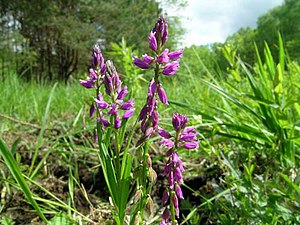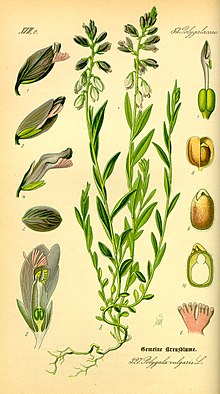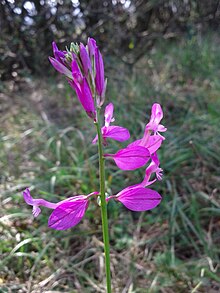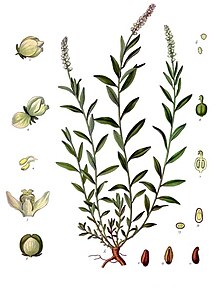Finials
| Finials | ||||||||||||
|---|---|---|---|---|---|---|---|---|---|---|---|---|

Scaly finial ( Polygala comosa ) |
||||||||||||
| Systematics | ||||||||||||
|
||||||||||||
| Scientific name | ||||||||||||
| Polygala | ||||||||||||
| L. |
The finials ( Polygala ) are the most diverse and most widespread genus of the finial family (Polygalaceae). The genus Polygala is also called cruciferous flowers in some floral works .
description

Vegetative characteristics
The finial species are annual or perennial herbs, also shrubs or small trees, very rarely lianas. Their leaves are simple, stalked, mostly alternate, rarely opposite or whorled. The leaves are entire, their blade is thin or leathery.
Generative characteristics
The finial types form racemose or double-racemate inflorescences . Each flower has a bract and at the base of the short flower stalk there are two bracts . The hermaphrodite flowers are zygomorphic with a double flower envelope . The five sepals are free, the side large and petal-like. There are three petals , the median (lower) is boat-shaped, the front often has a fringed appendage (Krista), the two upper ones are free and in some species (e.g. the native ones) each with the lower to about the The attachment point has grown together. The eight stamens form a tube open at the top with the filaments and are fused with the corolla tube along its entire length. The ovary is twofold; the fruit is a loculicidal (columnar) capsule fruit . The anthers consist of three of the Central European species ( Polygala chamaebuxus ), of the other species of two counters (pollen sacs that have grown together). The seeds have a three-lobed elaiosome .
ecology
Most of the native polygala species are predominantly autogamous ; cross- pollination is also rare ; mostly by butterflies and hymenoptera . With the exception of Polygala chamaebuxus , native Polygala species are pollinated as follows: Directly behind the appendage of the lower petal are two pockets on the side, each of which contains four of the eight anthers . Above this lies the front part of the stylus, which is widened like a spoon at the end . Behind this spoon is the bumpy, sticky scar . The anthers empty their pollen into the spoon. The insects land on the fringed appendage and push their proboscis into the corolla tube in order to get to the end of the nectar . The trunk brushes the sticky scar. When withdrawn, pollen sticks to it. When you visit the next flower, the pollen is dumped at its stigma. If there is a lot of pollen in the stylus spoon, the proboscis can push it onto the stigma as it penetrates, so that self-pollination occurs; Likewise, if there is no flower visit, the cicatricial hump curves forwards and against the spoon and is then pollinated by its own pollen. All species are largely self-fertile ; self-pollinated flowers have only a slightly reduced seed set and a completely normal germination .


Systematics and distribution
Except in Australia which is genus Polygala represented with about 600 species worldwide, making it the largest genus in the family of polygalaceae . In Germany about 12 species are known. On the edge of the distribution area, as in Central Europe , herbaceous plants predominate. Dwarf shrubs also appear further south.
The genus finials ( polygala ) includes around 600 species (selection):
In Central Europe:
- Pre-Alpine finial ( Polygala alpestris Rchb. )
- Western Alps finial ( Polygala alpina (DC.) Steudel ): It occurs only in the Pyrenees and in the French and Italian Alps.
- Bitter finial ( Polygala amara L. )
- Marsh finial ( Polygala amarella Cr. )
- Lime finial ( Polygala calcarea F.W. Schultz )
- Box finial , dwarf box ( Polygala chamaebuxus L. )
- Scaly finial ( Polygala comosa Schkuhr )
- Great finial ( Polygala major Jacq. )
- Quendelblättrige finial ( Polygala serpyllifolia Hosé )
- Common finial , common finial ( Polygala vulgaris L. )
More of the 33 or so species in Europe are (selection):
- Polygala microphylla L. , dwarf shrub, occurs only in Portugal and western Spain
- Polygala monspeliaca L. , occurs in the Mediterranean region, in Portugal and Bulgaria
-
Nice finial ( P. nicaeensis Risso ex WDJ Koch ), with at least seven subspecies, including:
- Krainer finial ( Polygala nicaeensis subsp. Carniolica (A.Kern.) P.Graebn. , Syn .: Polygala pedemontana E.P.Perrier & B.Verl. )
- Polygala rupestris Pourret , occurs in the western Mediterranean region
- Polygala venulosa Sibth. & Sm. , Occurs only in Greece, Crete, the Aegean Sea, Asia Minor and Cyprus.

And outside of Europe (selection):
- Myrtle finial ( Polygala myrtifolia L. ): It is native to South Africa, Australia, New Zealand and is a neophyte in places in France, Corsica and Sicily .
- Rattlesnake root ( Polygala senega L. ): It thrives on the prairies of eastern North America. Used by the Senega Indians as a remedy for coughs and rattlesnake bites. The active ingredients are triterpene saponins such as the senegins, oligosaccharide esters (e.g. senegoses) and small amounts of methyl salicylate. Before the First World War , the drug was also used in Europe for catarrh of the respiratory tract; later it was replaced by the native primrose root.
literature
- Oskar Sebald, Siegmund Seybold , Georg Philippi: The fern and flowering plants of Baden-Württemberg . Volume 4, Ulmer Verlag, Stuttgart 1992, ISBN 3-8001-3315-6 .
- Shu-kun Chen, Haiying Ma & John AN Parnell: Polygalaceae. Polygala Linnaeus , p. 139 ff. - the same text online as the printed work , In: Wu Zheng-yi, Peter H. Raven, Deyuan Hong (ed.): Flora of China. Volume 11. Science Press and Missouri Botanical Garden Press, Beijing and St. Louis 2010. (Description)
- R. Wisskirchen, H. Haeupler: Standard list of fern and flowering plants in Germany. Ulmer-Verlag, 1998, ISBN 3-8001-3360-1 .
- Siegfried Danert: Polygalaceae. Urania plant kingdom in 4 volumes, volume flowering plants 2, 2nd edition. 1976, pp. 54-55.
- Werner Greuter , HM Burdet, G. Long: Med-Checklist. Volume 4, Conservatoire et Jardin botaniques, Genève 1989, ISBN 2-8277-0154-5 , pp. 345-351.
Individual evidence
- ↑ Werner Greuter : Med Checklist . Volume 4 Dicotyledones (Compositae), pages 345-346, Conservatoire et Jardin botaniques, Genève 1989. ISBN 2-8277-0154-5
- ↑ Ingrid Schönfelder, Peter Schönfelder : The new manual of medicinal plants. Franckh Kosmos Verlag, Stuttgart 2004, ISBN 3-440-09387-5 , pp. 352-353.

